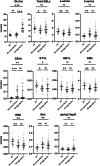Glycosphingolipid Changes in Plasma in Parkinson's Disease Independent of Glucosylceramide Levels
- PMID: 35876461
- PMCID: PMC10286748
- DOI: 10.1002/mds.29163
Glycosphingolipid Changes in Plasma in Parkinson's Disease Independent of Glucosylceramide Levels
Abstract
Background: Alteration in glycosphingolipids (GSLs) in Parkinson's disease (PD) still needs to be determined.
Objectives: We evaluated if PD subjects show abnormal GSLs levels compared to healthy controls (HC) and if GSLs correlate with clinical features.
Methods: We analyzed GSLs and glucosylceramide (GlcCer) in plasma using two normal-phase high-performance liquid chromatography assays; clinico-demographic data were extracted.
Results: Eighty PD subjects and 25 HCs were analyzed. Levels of GlcCer, GD1b, Gb4, GalNAcGA1, and b-series were higher in PD patients than in HCs; total GSLs, GT1b, GM1a, GM3, GM2, and a-series levels were lower in PD patients than in HCs. Changes in GSLs were present in PD subjects, with GlcCer levels similar to those in HCs. The results were similar after excluding certain GBA1 mutation carriers. Movement Disorder Society Unified Parkinson's Disease Rating Scale, Part III, correlated with Gb4 and Montreal Cognitive Assessment with GD1b levels.
Conclusions: Multiple GSL abnormalities in plasma were detected in patients with and without GlcCer changes, indicating a broader shift in lipid homeostasis. © 2022 The Authors. Movement Disorders published by Wiley Periodicals LLC on behalf of International Parkinson Movement Disorder Society.
Keywords: Parkinson's disease; glycosphingolipid; pathogenesis.
© 2022 The Authors. Movement Disorders published by Wiley Periodicals LLC on behalf of International Parkinson Movement Disorder Society.
Figures

References
Publication types
MeSH terms
Substances
Grants and funding
LinkOut - more resources
Full Text Sources
Medical

